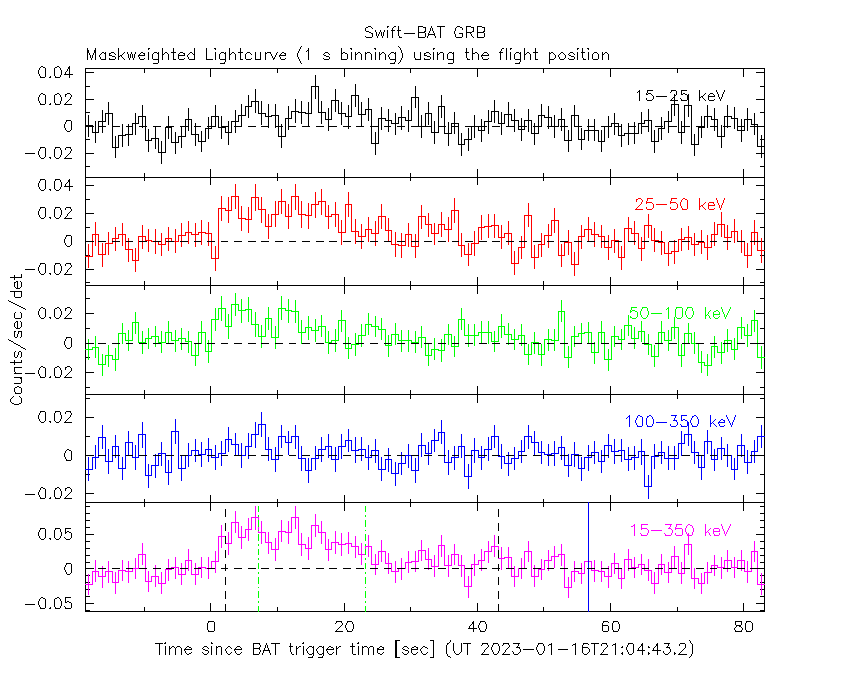
E. Sonbas (Adiyaman Univ.) and D.N. Burrows (PSU) for the Swift team
At 21:04:43 UT, the Swift Burst Alert Telescope (BAT) triggered and located GRB 230116D (trigger=1149293) (Sonbas et al. GCN Circ. 33176). Swift slewed immediately to the burst. At the time of the trigger, the initial BAT position was 147° from the Sun (10.7 hours East) and 127° from the 31%-illuminated Moon. Table 1 contains the best reported positions from Swift, and the latest XRT position can be viewed at http://www.swift.ac.uk/xrt_positions.
Zhu et al. (GCN Circ. 33177) reported the position from Xinjiang Astro. Obs. for the optical afterglow of this GRB. Moskvitin et al. (GCN Circ. 33187) determined a redshift of 3.81 from SAO RAS. Table 2 is a summary of GCN Circulars about this GRB from observatories other than Swift.
Standard analysis products for this burst are available at https://gcn.gsfc.nasa.gov/swift_gnd_ana.html.
As reported by Markwardt et al. (GCN Circ. 33194),
the BAT ground-calculated position is RA, Dec = 98.584, 49.831 deg which is RA(J2000) = 0
The BAT light curve (Figure 1) showed a complex structure with a duration of about 40 s.
The time-averaged spectrum from T+1.14 to T+53.144 s is best fit by a simple power-law model.
The power law index of the time-averaged spectrum is 1.38 ± 0.22.
The fluence in the 15-150 keV band is 8.12 ± 1.2 x 1
The results of the batgrbproduct analysis are available at https://gcn.gsfc.nasa.gov/notices_s/1149293/BA/.
Analysis of the initial XRT data was reported by Burrows et al. (GCN Circ. 33185). We have analysed 10 ks of XRT data for GRB 230116D, from 113 s to 68.2 ks after the BAT trigger. The data comprise 47 s in Windowed Timing (WT) mode (the first 10 s were taken while Swift was slewing) with the remainder in Photon Counting (PC) mode. The enhanced XRT position for this burst was given by Osborne et al. (GCN Circ. 33180).
The light curve (Figure 2) can be modelled with a series of power-law decays. The initial decay index is α=1.88 (+0.23, -0.21). At T+615 s the decay flattens to an α of 0.62 (+0.15, -0.20) before breaking again at T+8689 s to a final decay with index α=2.0 (+0.5, -0.4).
A spectrum formed from the PC mode data can be fitted with an absorbed power-law with a photon spectral index of 1.76 (+0.19, -0.11). The best-fitting absorption column is consistent with the Galactic value of 1.6 x 1
A summary of the PC-mode spectrum is thus:
Galactic foreground: 1.6 x 1
Intrinsic column: 1 ± 21 x 1
Photon index: 1.76 (+0.19, -0.11)
The results of the XRT team automatic analysis are available at http://www.swift.ac.uk/xrt_products/01149293.
UVOT results are not available.

Figure 1. The BAT
mask-weighted light curve in the four individual and total
energy bands. The units are counts

Figure 2. The XRT light curve.
Any data from a crosshatched region are not included in the fit.
| RA (J2000) | Dec (J2000) | Error | Note | Reference |
|---|---|---|---|---|
| 0 |
+49°52'22.3" | 2.0" | XRT-final | UKSSDC |
| 0 |
+49°52'20.6" | 2.3" | XRT-enhanced | Osborne et al. GCN Circ. 33180 |
| 0 |
+49°49'50.3" | 2.9' | BAT-refined | Markwardt et al. GCN Circ. 33194 |
| Band | Authors | GCN Circ. | Subject | Observatory | Notes |
|---|---|---|---|---|---|
| Optical | Zhu et al. | 33177 | Nanshan/NEXT optical afterglow detection | Xinjiang Astro. Obs. | detection |
| Optical | Nazarov et al. | 33178 | Sintez-Newton/CrAO optical afterglow detection |
CrAO | detection |
| Optical | Moskvitin et al. | 33179 | SAO RAS observations of OT brightening | SAO RAS | detection |
| Optical | G. Waratkar | 33181 | GIT optical follow-up | GROWTH-India Tel. | |
| Optical | Swain et al. | 33182 | GIT optical follow-up | GROWTH-India Tel. | detection |
| Optical | Moskvitin et al. | 33187 | SAO RAS redshift | SAO RAS | redshift |
| Optical | Strausbaugh and Cucchiara | 33188 | LCOGT Optical Upper Limit | Las Cumbres Obs. Global Tele.Network | upper limits |
| Optical | Belkin et al. | 33189 | Sintez-Newton/CrAO optical observations | CrAO | |
| Optical | Belkin et al. | 33190 | KGO RC-25 optical observations | KGO | |
| Optical | Belkin et al. | 33191 | SAO RAS photometry | SAO RAS | light curve |
| Optical | Moskvitin et al. | 33192 | SAO RAS further observations | SAO RAS | detection |
| Optical | Gupta et al. | 33198 | 3.6m DOT optical upper limit | DOT | upper limits |
January 20, 2023